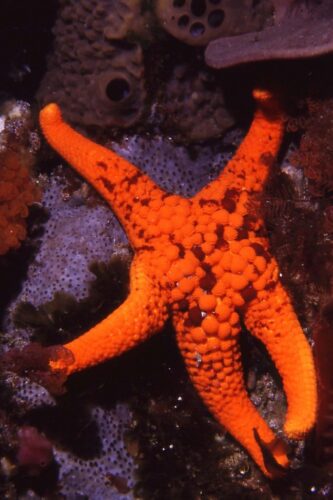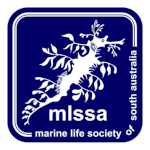Nectria sea star species have now been reduced by one
by Steve Reynolds
(STEVE’S SDFSA SCIENCE STORY OF THE MONTH OF JULY)
The number of Nectria sea star species has now been reduced to five. There were previously six Nectria seastar species but one of them has now been eliminated. According to the web page found at https://reeflifesurvey.com/breaking-nectria-cases-decrease/, confusion over the identification of two similar sea stars has now been resolved courtesy of Reef Life Survey volunteer Andrew Green.
Scientists are now listing five species of Nectria seastars as follows: –
Nectria pedicelligera, N. ocellata, N. macrobrachia, N. saoria & N. wilsoni. The multi-spined sea star, Nectria multispina has been eliminated from the list.
Scientists previously had difficulty distinguishing N. multispina from N. pedicelligera. When Graham Edgar was revising the section on Nectria for his updating of “Australian Marine Life” to a 3rd edition, his contact advised:
“Nectria pedicelligera is collected more frequently than N. multispina…. The two species don’t show any clear difference based on the data I have access to (e.g. no clear demarcation by depth etc.), but there’s still a lot we don’t know about these species. The distinguishing characters might easily be some kind of phenotypic variability related to predators, wave activity or something else.”
“So, Edgar went with N pedicelligera… and so has RLS. Meaning that if you submit survey records of N multispina, the RLS system will ‘port’ the data to N pedicelligera.
Caveats: Some well-respected authorities (including WoRMS) currently recognise both species. …… (But) New evidence could still arise confirming that N multispina does in fact exist alongside N pedicelligera!”
Photos of Nectria pedicelligera can be found at https://www.inaturalist.org/taxa/418059-Nectria-pedicelligera/browse_photos?place_id=6744.

Nectria pedicelligera
(Photo taken by David Muirhead – scanned from slide)
(Speaking of Reef Life Survey, they have postponed their Lap of Australia (and the majority of their field-based activities) until 2021. Before COVID-19 interrupted their Lap of Australia field plans, RLS managed to complete 705 surveys across 231 Australian sites. Further details can be found at https://reeflifesurvey.com/lap-of-aus-tracking/.)
For common names of Nectria sea star species, iNaturalist shows at list at https://www.inaturalist.org/taxa/207985-Nectria as follows: –
Nectria macrobrachia – Large-plated Sea Star
Nectria ocellata – Spotted Sea Star
Nectria saoria – Saori’s Sea Star
Nectria pedicelligera – (no common name)
Nectria multispina – (no common name) – Possibly should actually be Nectria pedicelligera
Nectria wilsoni – (no common name)
The late Neville Coleman applied the following common names for Nectria species: –
N.occellata – Ocellate sea star
- wilsoni – Wilson’s sea star
- macrobranchia – Large-armed sea star
- saoria – Saori sea star
There is still no known name for Nectria pedicelligera, so we need to either stick to the scientific names or come up with a common name like Neville Coleman would. Does anyone know pedicelligera means?


Good stuff Steve. I don’t know what pedicelligera means off the top of my head but it probably relates in some way to the layout of the little upright components that make up each of the more or less round, raised discs located centrally on the seastar’s dorsum.
Although with pedi meaning foot perhaps its something to do with the ventral anatomy not dorsal…totally guessing now,I should just google it!